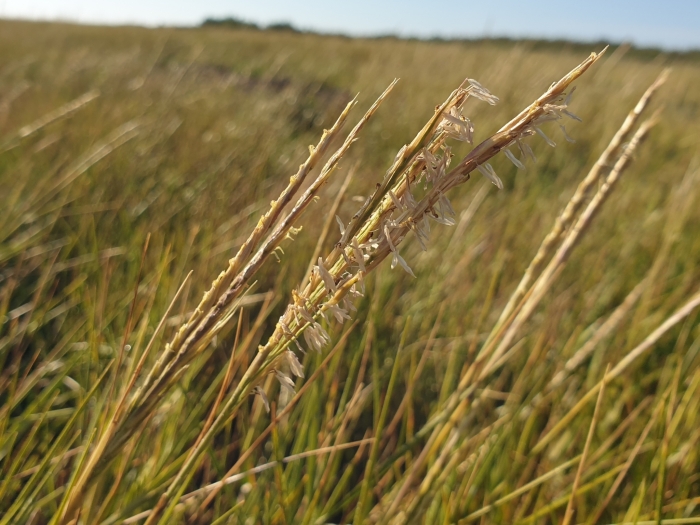Small Cordgrass
(Sporobolus maritimus)
Small Cordgrass (Sporobolus maritimus)
/
/

© Clément Maouche
CC BY 4.0
Image By:
© Clément Maouche
Recorded By:
Copyright:
CC BY 4.0
Copyright Notice:
Photo by: © Clément Maouche | License Type: CC BY 4.0 | License URL: http://creativecommons.org/licenses/by/4.0/ | Uploader: clementm | Publisher: iNaturalist |

























Estimated Native Range
Summary
Sporobolus maritimus, commonly known as small cordgrass, is a perennial grass native to coastal salt marshes and intertidal zones in western and southern Europe, North Africa, and along the Mediterranean and Black Sea coasts. It is typically found in areas with soft mud or shingle, often in the upper reaches of saltmarshes where it is less exposed to wave action. This species plays a crucial role in stabilizing these ecosystems by trapping sediments with its dense root systems. It grows 8 to 28 inches tall, with slender, wiry leaves and a dense, spike-like inflorescence that appears in late summer to fall.
Small cordgrass is valued for its ability to thrive in saline environments and is often used in coastal restoration projects to prevent erosion. Its dense growth habit makes it suitable for creating natural barriers against waves and wind. In cultivation, it requires full sun and can tolerate a range of soil types, provided they are well-drained and saline. It is relatively low-maintenance, needing minimal care once established. However, it can be invasive outside its native range, so caution is advised when planting it in non-native areas.CC BY-SA 4.0
Small cordgrass is valued for its ability to thrive in saline environments and is often used in coastal restoration projects to prevent erosion. Its dense growth habit makes it suitable for creating natural barriers against waves and wind. In cultivation, it requires full sun and can tolerate a range of soil types, provided they are well-drained and saline. It is relatively low-maintenance, needing minimal care once established. However, it can be invasive outside its native range, so caution is advised when planting it in non-native areas.CC BY-SA 4.0
Plant Description
- Plant Type: Grass
- Height: 1-3 feet
- Width: 2-3 feet
- Growth Rate: Moderate
- Flower Color: N/A
- Flowering Season: Summer, Fall
- Leaf Retention: Evergreen
Growth Requirements
- Sun: Full Sun
- Water: Medium
- Drainage: Medium, Fast
Common Uses
Erosion Control, Low Maintenance, Salt Tolerant
Natural Habitat
native to coastal salt marshes and intertidal zones in western and southern Europe, North Africa, and along the Mediterranean and Black Sea coasts
Other Names
Common Names: Saltmarsh Dropseed, Alkali Dropseed
Scientific Names: , Sporobolus maritimus, Cynodon pungens, Dactylis cynosuroides, Dactylis maritima, Dactylis stricta, Limnetis pungens, Paspalum strictum, Poa ternitana, Poa ternitana
GBIF Accepted Name: